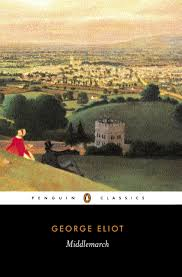Most (or should that be many?) Victorian novels end with a marriage. The bedroom door is closed on the newly-weds, and other than the occasional “we lived happily ever after”, the story closes. (Jane Eyre famously ends with “Reader, I married him” – except of course that it doesn’t, and Jane’s narration gives us a glimpse of her happy married life with Rochester (“I have now been married ten years. I know what it is to live entirely for and with what I love best on earth….No woman was ever nearer to her mate than I am: ever more absolutely bone of his bone and flesh of his flesh”). The conventional narrative arc follows the couple on a long and often difficult journey, and ends with their wedding as the culmination of the relationship, whether it is Emma and Mr Knightley, Jane and Mr Rochester, or Elizabeth and Mr Darcy.
Middlemarch inverts that convention, and opens with a marriage, between a couple who are intellectually suited but otherwise unlikely. Dorothea, nicknamed Dodo by her sister, emphasising were it necessary her awkwardness, while still a minor (i.e. under the age of 21) falls for Reverend Casaubon, a dry as bones vicar more than twice her age. Eliot goes out of her way to emphasise Casaubon’s physical unattractiveness and decrepitude – we see him not just through Dorothea’s eyes, but also from the perspective of her sister, Celia, who comments tellingly on his “white moles with hairs on them”. One of the strengths of the novel is Eliot’s sophisticated use of point of view – her narrator will often intrude personally into the novel, but at other times more subtly takes the perspective or voice of one or other of her characters.
Eliot tells us in the novel’s introduction how to interpret the events about to be portrayed:
“Here and there a cygnet is reared uneasily among the ducklings in the brown pond, and never finds the living stream”.
Middlemarch is the brown pond, Dorothea the cygnet doomed to spend her life cut off from the living stream. I’ll discuss Dorothea and Casaubon’s relationship in more detail in a separate post – it is central to the novel – but the reader is given many strong hints that marriage is doomed to unhappiness from the start. When Will Ladislaw, Casaubon’s cousin, is introduced, the threat to the marriage is obvious. Eliot seems obsessed with Ladislaw’s hair, relentlessly referring to his “light brown curls” and his “bushy light-brown curls”, emphasising his vitality in contrast to that of his cousin.
Middlemarch is widely considered one of the great Victorian novels. It is certainly very long, and has an extensive cast. The Midlands setting is largely irrelevant – this could be also anywhere in England, except perhaps London, and while most commentators think the political context, the years preceding the 1832 Reform Act, is significant, the concept of a country in the process of momentous change intrudes only briefly, when the railways start to come to Middlemarch, and is otherwise largely irrelevant. The narrative is complex and weaves together numerous smaller plotlines, although Dorothea’s story, and the career of Dr Lydgate, the two tales from which the novel was originally woven, are the principal components.
The novel’s mechanics, whereby the dark secrets of Mr Bulstrode, the town’s financier, are revealed by his blackmailer whilst drunk, have a distinctly Dickensian feel to them, and are some of the novel’s least successfully parts. They are heavily flagged “plot devices happening here, pay attention, this is important”. Anyone reading ‘Middlemarch’ to learn about nineteenth century life in middle England will be sadly disappointed – the principal characters are drawn from a narrow social class, and will the working class and agricultural labourers are represented (unlike in, say, Austen) they are all bit-part players primarily there for comic relief. Eliot claims to be giving the little people a voice – the novel concludes “that things are not so ill with you and me as they might have been, is half owing to the number who lived faithfully a hidden life, and rest in unvisited tombs”. These are the people who have made this country through their small, undramatic efforts.
Is the novel worth reading, and is it a success. I confess my first reading of ‘Middlemarch’ several decades ago left on the barest impression, that of the unlikelihood of Dorothea and Casaubon’s relationship. Other characters left barely a trace. I found reading the novel a labour the second time of asking – it is less than the sum of its parts, and I found no-one to identify with or engage my interests. I really didn’t care what happened to them all; they rarely became living creations, are remained mostly people in a book. I appreciate this is to many complete heresy, and is a personal reaction rather than a well-constructed criticism of the novel itself. But I did find plenty of interest in the relationship between Dorothea and Casaubon, and that will be the focus of my next blog entry – watch this space!
Such a shame you didn’t enjoy this so much. Its my favourite victorian novel because its so rich in meaning and ideas. Your comment that Eliot inverts the normal arc is another example of how she plays with genre -the whole introduction and the epilogue is designed to make us feel that Dodo is not a heroine – she’s someone who makes only a small mark on the world and yet without her it would be infinitely worse.
LikeLike
Thanks for your comment. I definitely was able to appreciate the novel more this time round, but yes, sadly, it wasn’t love at second read. I agree Dodo isn’t a heroine, but Eliot consistently compares her to St Theresa and/or the Virgin Mary. For me she is the most interesting character – most of the men are frustratingly obtuse. Have you reviewed it, or any other Eliot?
LikeLike